
23. Oost 1, Model yachts
The Netherlands has a rich tradition of sailing for pleasure. From the second half of the sixteenth century onwards, rich merchants and governors bought elegantly ornamented yachts for business meetings, visits to markets and for trade. They were also for enjoying themselves on the water with their families, during their leisure time. What visitors most often notice about the old model ships are the two outriggers. Because Dutch waters are often fairly shallow, inland water vessels here often don’t have a keel but are instead rounded or flat on the underside. To compensate for the lack of a keel, vessels were given two outriggers. This prevents the vessels from deviating too far from their course when there is a side wind. One of these outriggers would be lowered at any given time, on the opposite side to the direction that the wind was coming from. In nautical terms, that is the leeward side. A number of model yachts are exhibited here, ranging from the traditional to the ultra-modern. Many of the traditional types of boats can still be seen sailing around the Dutch inland waters.


The National Maritime Museum
Het Scheepvaartmuseum (The National Maritime Museum) shows the strong connection between the maritime world and society as a whole, and more specifically the impact of this on the lives of many individuals. The collection of The National Maritime Museum is one of the largest and most notable maritime collections in the world with approximately 400,000 objects, including paintings, models of ships, navigation instruments, and maps of the world. Discover 500 years of Dutch Maritime history as well as its strong links to today’s society and the society of the future.
- Kattenburgerplein 1
- Amsterdam Netherlands
- (020) 52 32 222
- www.hetscheepvaartmuseum.nl
